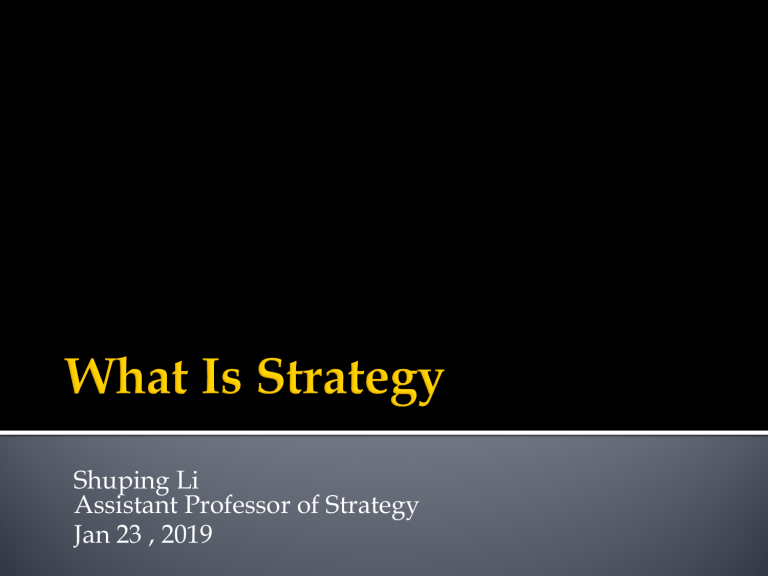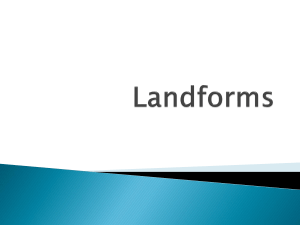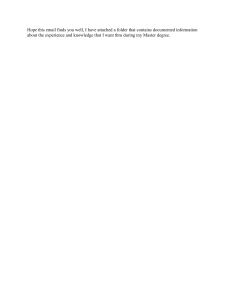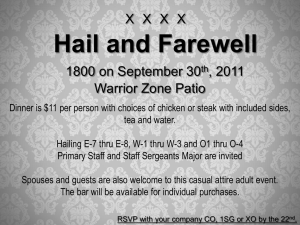
Shuping Li Assistant Professor of Strategy Jan 23 , 2019 Shuping Li Assistant Professor of Strategy Jan 25 , 2019 ¡ A strategy is a choice ¡ Yet, not all the choices are strategic 3 4 ¡ You have exactly 2 weeks to get to the claims office. ¡ If you arrive late and attempt to secure the property (with the owners knowing you have visited it), there will probably be an auction at which you could be easily outbid. ¡ You’ve remained relatively healthy except for an injured left hand, which can suddenly become quite weak. ¡ The weather is only moderately favorable. You will know within 48 hours if the storm is coming, and whether the mountain is passable (if the storm comes) about one day later. 5 Option #1 (wait 3-4 weeks) #2 (over top) #3 (valley) #4 (wait 3 days) Min. Time Max. Time Outcome No $$$s Personal Risk None Option 1: wait 3-4 weeks until the weather warms up and enjoy a safe trip home. 6 Option #1 (wait 3-4 weeks) #2 (over top) #3 (valley) #4 (wait 3 days) Min. Time 7 days Max. Time 10 days Outcome Personal Risk No $$$s None For sure $$$s Life Option 2: go over the mountains. 7 Option #1 (wait 3-4 weeks) #2 (over top) #3 (valley) #4 (wait 3 days) Min. Time Max. Time Outcome Personal Risk No $$$s None 7 days 10 days For sure $$$s Life 14 days 21 days Maybe $$$s None Option 3: go through the valley passes 8 Option #1 (wait 3-4 weeks) #2 (over top) #3 (valley) #4 (wait 3 days) Min. Time Max. Time Outcome Personal Risk No $$$s None 7 days 10 days For sure $$$s Life 14 days 21 days Maybe $$$s None 10 days thru top 13 days thru top $$$, if no storm Some risk for over the mountains 17 days thru valley 24 days thru valley No $$$s, if storm Option 4: wait 2-3 days, take #2 if weather permits; if not, take #3. 9 The Environment “Threats & Opportunities” Utilization of resources and capabilities“Strengths & Weaknesses” Performance Choice Inherent attitude toward risk Trade-off among alternatives 10 Option #1 (wait 3-4 weeks) #2 (over top) #3 (valley) #4 (wait 3 days) Min. Time Max. Time Outcome Personal Risk No $$$s None 7 days 10 days For sure $$$s Life 14 days 21 days Maybe $$$s None 10 days thru top 13 days thru top $$$, if no storm Some risk for over the mountains 17 days thru valley 24 days thru valley No $$$s, if storm 11 ¡ 4 days later you are halfway to the claims office. ¡ You’ve pushed too hard and sprained your ankle. ¡ Pat, an old friend on a trapping expedition, comes along and takes you to a cabin. ¡ Pat, you suspect, both need and desire financial independence. 12 Option #1 (Go with Pat ) #2 (Go alone) #3 (Send Pat) Min. Time Max. Time Outcome Personal Risk 10 days 14 more days 20% likely Moderate 15 days 19 more days 0% Low 8 days 9 more days 50% likely High 13 The Environment “Threats & Opportunities” Competitive advantage RELATIVE to rivals management Utilization of resources and capabilities“Strengths & Weaknesses” STRATEGY Inherent values & attitude toward risk Trade-off among strategic alternatives 14 ¡ Is there a competition involved? ¡ Is the performance an absolute outcome or a relative advantage? ¡ Can the performance be influenced through “management” of internal and external conditions? 15 ¡ A set of major choices managers make to utilize a firm’s internal resources to enhance the firm’s competitive advantage in its external environments. ¡ Corporate strategy ¡ Business strategy ¡ Functional strategy 16 ¡ Competitive advantage: The ability to obtain a profitability greater than the average, usually in an industry § Shareholder return (ROE) § Investment return (ROIC, ROA) § Changes in stock price § Profit growth § Sales growth ¡ Sustained competitive advantage: A firm maintains competitive advantage for a long period of time 17 Source: Bloomberg.com 18 Source: The Economist 19 Source: yahoofinance.com 20 1990 1) Merck 2) Philip Morris 3) Rubbermaid 4) Procter & Gamble 5) 3M 6) PepsiCo (tie) 7) Wal-Mart (tie) 8) Coca-Cola 9) Anheuser Busch 10) DuPont 2000 1) General Electric 2) Microsoft 3) Dell Computer 4) Cisco Systems 5) Wal-Mart 6) Southwest Airlines 7) Berkshire Hathaway 8) Intel 9) Home Depot 10) Lucent Technologies 2010 1) Apple 2) Google 3) Berkshire Hathaway 4) Johnson & Johnson 5) Amazon.com 6) Procter & Gamble 7) Toyota Motor 8) Goldman Sachs 9) Wal-Mart 10) Coca-Cola The Fortune “Most Admired” Survey Source: http://money.cnn.com/magazines/fortune/mostadmired/2010/full_list/ 21 What to sell? Who to serve? How to win? Choices about Who, What, How 22 Who are the interviewers What to sell about myself? How to deliver my unique value to outperform? Choices about Who, What, How 23 ¡ 16% sales from the AsiaPacific region v. 19% from the U.S. during 2013 fiscal year. ¡ Trying to return to growth after declining phone shipments dragged it to net losses in the past 3 years BlackBerry CEO John Chen “I’m here this time to look at what opportunities there may be. We have not really focused on this market. It’s a huge market but it’s a very highly competitive market too.” 24 What needs? Who to serve? Enterprises, government How to win? security, encryption , and privacy Partnership: licensing, distribution 25 ¡ Trade-off § Choose what not to do ¡ Overarching and integrated § “Big Picture” and “Fit” ¡ Unique § Position differently from the competitors ¡ Sustainable § Not easily reversible; sustainable competitive advantage 26 ¡ Tactics: maneuvers for pursuing an objective associated with a strategy § Below the shoulders § Short-term § Flexible to specific market changes Necessary but NOT sufficient 27 ¡ Operational effectiveness: Performing similar activities better, cheaper, faster, or wider than rivals § Not unique in “how to do” § Temporary performance Necessary but NOT sufficient 28 ¡ Internal organizational arrangements: compensation policies, information systems, training programs § Not involving external environment Necessary but NOT sufficient 29 External Analysis Mission Strategic Choice Objectives Internal Analysis Strategy Formulation Strategy Implementation Competitive Advantage Strategy Implementation 30 External Analysis Mission Strategic Choice Objectives Strategy Implementation Competitive Advantage Internal Analysis 31 ¡ WHY? What is our purpose? What are we about? § Present § Describes the major product/services/markets § Externally focused ¡ Provides the framework or context within which strategies are formulated 32 Mission Statement Vision Our Mission is to discover, design and deliver Innovation-driven Education and Scholarship (IDEAS) of international standing that has an impact on students, organizations and the understanding of business issues. To be a leading business school in Asia. Present Future Who we are, what we do, and why we are here! Where are we going? 33 ¡ Not necessary… § Many firms don’t have a mission (e.g., Ruby’s) § Weak sense of how a business competes or how it delivers value to a customer ¡ But, can be very useful (if well written) § Helps differentiate a firm from its competitors at the highest level 34 ¡ “To be the happiest place on earth” ¡ “To organize the world’s information and make it universally accessible and useful.” 35 ¡ “To help people save money so that they can live better.” ¡ “To build a place where people can come to find and discover anything they might want to buy online.” ¡ “A computer on every desk and in every home.” 36 External Analysis Mission Strategic Choice Objectives Strategy Implementation Competitive Advantage Internal Analysis 37 ¡ Timely § Fixed time frame (e.g., 1 yr) § Both long-term and short-term ¡ Measurable § Indicators (e.g., sales growth) that reflect progress ¡ Specific ¡ Realistic § Challenging but achievable (e.g., increase ROA by 2%) 38 External Analysis Mission Strategic Choice Objectives Strategy Implementation Competitive Advantage Internal Analysis 39 ¡ External analysis § Identify strategic opportunities and threats ▪ Industry environment ▪ National environment ▪ Socioeconomic or macro-environment ¡ Internal analysis § Identify strengths and weaknesses of firm resources and capabilities 40 41 External Analysis Mission Strategic Choice Objectives Internal Analysis Strategy Implementation Competitive Advantage Function level strategy How to support a business strategy? Business level strategy How to position a business in a market? Corporate level strategy Which businesses to enter? 42 Implementation Levers: ØOrganization structure ØOrganizational control ØOrganizational culture External Analysis Mission Strategic Choice Objectives Strategy Implementation Competitive Advantage Internal Analysis Balance between control and incentive 43 Feedback External Analysis Mission Strategic Choice Objectives Strategy Implementation Competitive Advantage Internal Analysis 44 45 ¡ 1. What are the typical views of Strategy in the U.S. vs. in Japan? ¡ 2. Why did the British demise in the world’s motorcycle industry diminish U.S.? ¡ 3. Summarize Honda’s success in Japan and in the U.S. ¡ 4. According to BCG report, what are the major contributors to Honda’s success in the U.S.? ¡ 5. According to the article, what are the real reasons for Honda’s success? ¡ 6. What are the implications for firms’ strategy making? 46 ¡ Major competitors in the U.S. motorcycle market prior to 1960s: Harley-Davidson, Tiumph and Norton, and Moto-Guzzi ¡ From 1959 to 1973, the British share of the U.S. motorcycle industry had dropped from 49% to 9%, while Honda’s share increased from 4% to over 63% ¡ 1975, BCG presented Strategic Alternatives for the British Motorcycle Industry 47 ¡ Deliberate (design) view § Logical, rational analysis of the firm and the environment § § § § Communicated downwards by TMT Conscious redefinition of the market—region by region Aggressive advertising campaigning Scale economies 48 ¡ Planned to sell 250-350cc motorcycles to “black leather jacket” customers 49 50 51 ¡ Product related problems arose ¡ Honda executives rode around Los Angeles on 50cc bikes ¡ Eventually, attracted new types of customers for its small bikes and became phenomenally successful § $500k to $77m from 1960 to 1965 § 63% of the lightweight motorcycles in 1966 52 ¡ Deliberate (design) view § § § § § ¡ Logical, rational analysis of the firm and the environment Communicated downwards by TMT Conscious redefinition of the market—region by region Aggressive advertising campaigning Scale economies Emergent (process) view § § § § § Strategy “emerges” from an unplanned pattern of decisions Lower level managers and employees Adaptation and continuous learning Key segmentation (young families)– happened by chance Made by lower level employees 53 Realized strategy consists of both intended and emergent strategies. 54




